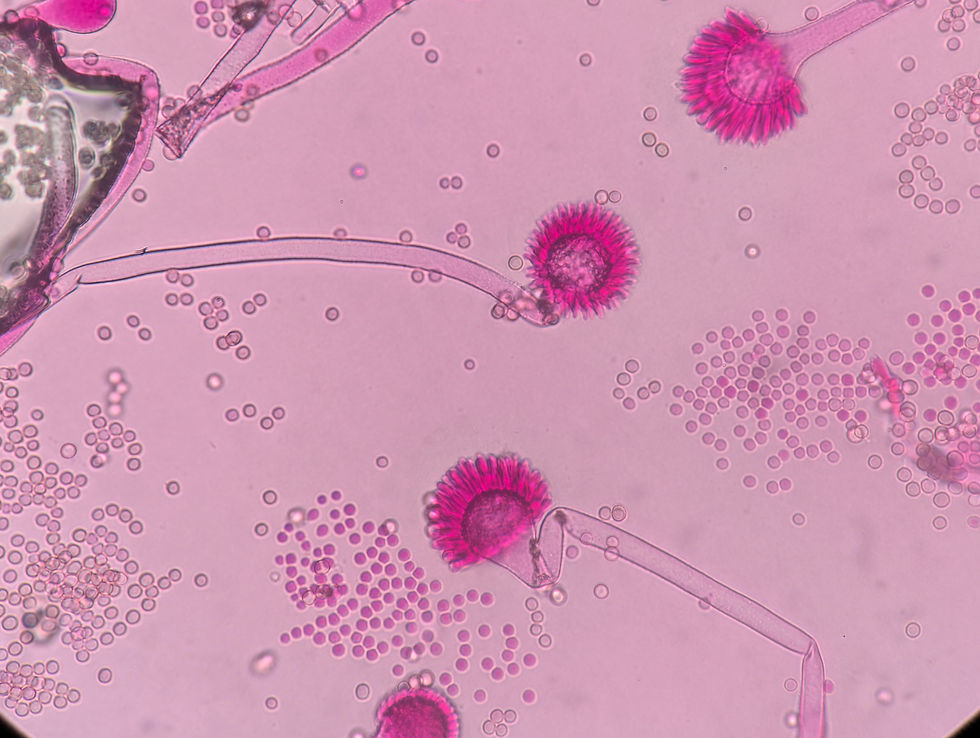Common Koi Parasites: Prevention and Treatment Tips
- Tri-Star Koi
- 3 days ago
- 4 min read
By Tri-Star Koi
Parasites are one of the biggest challenges koi keepers face. They can stress your fish, cause health issues, and if left unchecked, lead to serious outbreaks that can devastate your pond. At Tri-Star Koi, we believe knowledge is your best defense—understanding which parasites are common, how to spot them, and how to prevent or treat infestations is key to keeping your koi happy and healthy.
Let’s dive into the most common parasites in the koi hobby, what signs to watch for, and how you can protect your pond.
Common Koi Parasites
1. Ich (Ichthyophthirius multifiliis)
Also known as "white spot disease," ich is one of the most well-known koi parasites.
Signs: Small white spots resembling sugar grains on the skin and gills, flashing (scratching against surfaces), lethargy.
Prevention: Quarantine new fish, maintain good water quality, avoid sudden temperature changes.
Treatment: Formalin baths, Salt at 0.6%, or malachite green treatments. Treat the entire pond if necessary.
2. Flukes (Gyrodactylus and Dactylogyrus)
Skin and gill flukes are tiny flatworms that attach to koi and cause irritation.
Signs: Excess mucus, flashing, rapid breathing, clamped fins, lethargy.
Prevention: Regular quarantine and observation, keep water clean, avoid overcrowding.
Treatment:
Praziquantel baths or dips: Highly effective against external parasites like Trichodina.
Formalin treatments: Often used to control external parasites; follow dosage instructions carefully.
Maintain excellent water quality: Regular water changes and proper filtration reduce stress and support recovery.
Potassium permanganate (KMnO4): Can be used in a series of treatments but only if you’re experienced with this strong oxidizer.
Flubendazole: An effective anti-parasitic medication often used as a bath treatment to eliminate parasites like Flukes.
3. Anchor Worms (Lernaea)
These are crustacean parasites that burrow into the skin.
Signs: Visible thread-like worms protruding from the skin, redness, ulcers around attachment sites.
Prevention: Quarantine, avoid introducing infected fish, maintain water quality.
Treatment: Manual removal followed by salt baths and antiparasitic medications. Dimlin-X (Follow instructions)
4. Fish Lice (Argulus)
Fish lice are flat, shield-shaped parasites that attach to koi.
Signs: Fish rubbing against surfaces, visible lice on skin, red sores.
Prevention: Quarantine and good pond hygiene.
Treatment: Manual removal, antiparasitic dips, salt baths, Dimlin- X.
5. Trichodina
A common protozoan parasite found on koi skin and gills.
Signs: Excess mucus, flashing, respiratory distress.
Prevention: Maintain water quality and quarantine new fish.
Treatment:
Praziquantel-Highly effective against external parasites including Trichodina. Usually administered as a bath or dip.
Formalin- Effective parasite treatment. Often combined with malachite green for broader parasite control.
Malachite Green- Works well in combination with formalin to treat external parasites.
Flubendazole- A safe and effective anti-parasitic bath treatment for Trichodina.
Salt Baths- Adding salt (0.3%-0.5%) helps reduce parasite load and soothe fish.
Potassium Permanganate (KMnO4)- Can be used carefully for parasite control, but only if you’re experienced with this oxidizer.
6. Costia (Ichthyobodo)
Costia is a small flagellate protozoan parasite that can affect koi, especially under stress.
Signs: Excess mucus production, clamped fins, lethargy, flashing.
Prevention: Keep water clean, reduce stress, quarantine new fish.
Treatment:
Formalin – Very effective against Costia; typically used as a bath treatment.
Malachite green – Often combined with formalin for more effective parasite control.
Potassium permanganate (KMnO4) – Effective but should be used carefully due to its strong oxidizing properties.
Salt baths – Adding aquarium salt (about 0.3%-0.5%) can help reduce parasite stress and aid recovery.
Praziquantel – Primarily used for flukes but may have some effect on other external parasites.
Flubendazole – Anti-parasitic treatment that can also help with Costia infestations.
Preventing Parasite Problems
The best cure is prevention. Here’s how you can keep parasites at bay:
Quarantine New Koi: Always quarantine new arrivals for at least 2–4 weeks and monitor for signs of parasites.
Maintain Excellent Water Quality: Clean water reduces stress and strengthens your koi’s immune system.
Avoid Overcrowding: Too many fish mean more stress and easier parasite spread.
Regular Pond Maintenance: Clean filters, remove debris, and perform regular water changes.
Routine Health Checks: Observe your koi daily for unusual behavior or spots. Early detection makes treatment easier. (Microscope)
Treating Parasites
In koi ponds, it’s safest to assume that if one fish shows signs of parasites, others may be affected as well—even if symptoms aren’t visible yet. That’s why treating the entire pond is the most effective approach to fully control and eliminate parasites.
Treat the Whole Pond: Parasites can spread quickly, so treating the entire pond helps prevent reinfection and protects all your fish.
Follow Dosage Instructions Carefully: Use medications as directed to avoid harming your fish or beneficial bacteria.
Multiple Treatments May Be Necessary: Some parasites have life cycles that require repeated treatments to fully eradicate.
Isolate Severely Affected Fish: If possible, move sick fish to a hospital tank for more intensive care.
Consult Experts When Needed: If you’re unsure about diagnosis or treatment, seek advice from koi health professionals or your trusted supplier.
Parasites are an unavoidable part of koi keeping, but with vigilance and proper care, you can minimize their impact. Prevention through quarantine, water quality management, and regular observation is your first line of defense. When treatment is needed, timely and appropriate medication will help your koi bounce back.
— Marlon @ Tri-Star Koi





